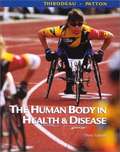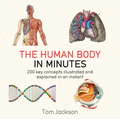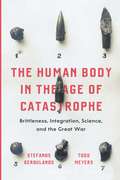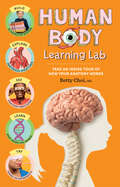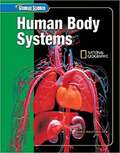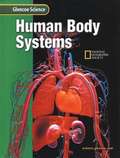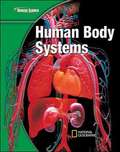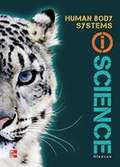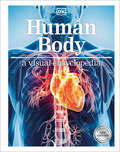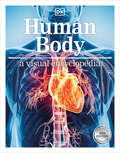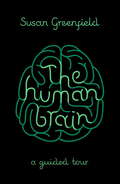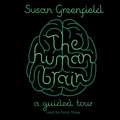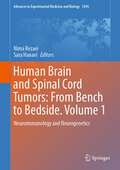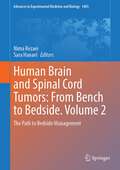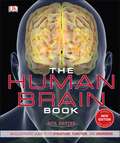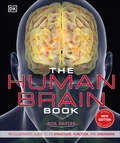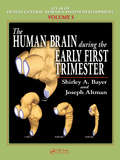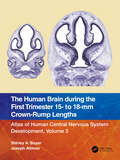- Table View
- List View
The Human Body in Health & Disease (3rd Edition)
by Gary A. Thibodeau Kevin T. PattonThis third edition includes outstanding coverage of basic anatomy and physiology, plus the mechanisms of disease and pathologic conditions associated with each body system. Two unifying themes are integrated in this comprehensive text: the complementary nature of structure and function, and homeostasis. Homeostasis is used to show how "normal" structure and function are maintained, whereas failures of homeostasis are shown as basic mechanisms of disease. The reader is drawn into the subject by a clear, straightforward style, superior illustrations, and student-friendly features.
The Human Body in Minutes (IN MINUTES)
by Tom JacksonA concise and illuminating tour of the human body - learn about how our bodies work and why they work the way they do, in minutes. From the basic unit of the cell, through the tissues and organs that make up the body's systems, to how these systems work together to form a complete human being, this book takes you on a journey through our anatomy and its intricate workings - and looks beyond to explore human evolution, inheritence and genetics, human behaviour, disease, death and medicine and how technology will transform the body of the future.With 200 cutting-edge anatomical images, cross-sections and close-ups that detail and explain the brain, eye, heart, skin, skeleton, lung, kidney, ear, blood, liver, stomach, muscles, veins, arteries, DNA, chromosomes and all of the key features of our bodies, this is the perfect, easy reference to the anatomy, physiology and science of the human body.
The Human Body in the Age of Catastrophe: Brittleness, Integration, Science, and the Great War
by Stefanos Geroulanos Todd MeyersThe injuries suffered by soldiers during WWI were as varied as they were brutal. How could the human body suffer and often absorb such disparate traumas? Why might the same wound lead one soldier to die but allow another to recover? In The Human Body in the Age of Catastrophe, Stefanos Geroulanos and Todd Meyers uncover a fascinating story of how medical scientists came to conceptualize the body as an integrated yet brittle whole. Responding to the harrowing experience of the Great War, the medical community sought conceptual frameworks to understand bodily shock, brain injury, and the vast differences in patient responses they occasioned. Geroulanos and Meyers carefully trace how this emerging constellation of ideas became essential for thinking about integration, individuality, fragility, and collapse far beyond medicine: in fields as diverse as anthropology, political economy, psychoanalysis, and cybernetics. Moving effortlessly between the history of medicine and intellectual history, The Human Body in the Age of Catastrophe is an intriguing look into the conceptual underpinnings of the world the Great War ushered in.
Human Body Learning Lab: Take an Inside Tour of How Your Anatomy Works
by Betty ChoiPediatrician and popular homeschooling blogger Dr. Betty Choi takes kids on an engaging exploration of the inner workings of all the major systems of the human body, with hands-on learning lab experiments, colorful diagrams and infographics, model building, and challenging games.
Human Body Systems: Book D (Glencoe Science)
by McGraw-Hill EducationHuman Body Systems, as a part of the Glencoe Science 15-Book Series, provides students with accurate and comprehensive coverage of the human body and its key organ systems. The strong content coverage integrates a wide range of hands-on experiences, critical-thinking opportunities, and real-world applications. The modular approach allows you to mix and match books to meet your curricula.
Human Body Systems: Course D
by McGraw-Hill Glencoe"Science meets students where they are through engaging features and thought-provoking questions that encourage them to relate the science concepts to the world around them.
Human Body Systems
by Glencoe Mcgraw-HillDiscover the Flexibility to Teach Science Your Way!. "Glencoe Science: Human Body Systems," a module in the Glencoe Science 15 book series, provides students with accurate and comprehensive coverage of middle school National Science Education Standards. Concepts are explained in a clear, concise manner, and are integrated with a wide range of hands-on experiences, critical thinking opportunities, real-world applications, and connections to other sciences and to non-science areas of the curriculum. Co-authored by National Geographic, unparalleled graphics reinforce key concepts. A broad array of print and technology resources help differentiate and accommodate all learners. The modular approach allows you to mix and match books to meet your specific curriculum needs.
Human Body Systems IScience
by Glencoe Mcgraw-Hill American Museum of Natural HistoryMiddle School Science
Human Body: A Visual Encyclopedia (DK Children's Visual Encyclopedias)
by DKLook inside yourself for the first time with the ultimate body book for children. From the hair on your head to the tips of your toes, this essential encyclopedia explores the super science going on under your skin.Did you know your amazing body consists of 100 trillion cells? Or that your blood vessels laid out end to end would wrap around planet Earth twice? And that you&’ll munch through 20 tonnes of food in your lifetime? Find out all this and much more on the epic journey of self-discovery, not forgetting your heads, shoulders, knees, and toes! During this introduction to anatomy, you&’ll stop off to see the different organs and systems designed to keep us going all day long. Check out the brilliant brain in action at the body&’s control center, the heart that never stops beating, the huge lungs filling with air to breathe, and the strong skeleton that keeps you from turning to jelly. Peel back the layers as you go deeper into the muscles, bones, cells, and finally, the DNA that makes you different from everyone else. This international best-seller has been fully updated to include the latest research on the human body. Stunning photographs, CGI artworks, and eye-catching graphics work together with accessible text, fun-filled facts, and quirky quizzes to ensure an exciting and educational experience that is second to none. This brilliant body book is the perfect study aid or homework help – and you&’ll never see yourself in the same way again!Supports the Common Core State Standards.
Human Body A Visual Encyclopedia
by DKUnderstand the human body from head to toe with this educational encyclopedia for children.Get to know how each part of the body works through amazing facts and colorful diagrams in this fully updated edition of the bestselling Human Body A Visual Encyclopedia.Did you know that you are made up of 100 trillion cells? Learn about blood vessels (capillaries, veins, and arteries) which, if they were laid out end to end, would wrap around the Earth twice! Find out what makes a balanced diet - after all, you will eat about 20 tons of food in your entire life!This human body book for kids offers: How the body works, looking at body parts and functions like bones and muscles, heart and blood, disease defenses, the life cycle, and much more.A human body encyclopedia that is suitable and informative for children aged 9+.A refreshed and updated edition, including a new design and the latest facts and stats on the human body.Make your way from the skin, muscles, organs, and bones, right down to your cells and DNA with this encyclopedia that combines clear descriptions of human biology with awesome photographs, diagrams, and CGI artworks. There are also fun quizzes, so you can assess your own personality and test your logical and reasoning skills.Explore the series!Globally, the Children’s Encyclopedia series has sold more than 4 million copies worldwide. Uncover the marvels of our world with Science, explore the deep blue with Ocean, explore our solar system and beyond with Space, and get to grips with world-famous sculptures with Art.
The Human Brain: A Guided Tour (SCIENCE MASTERS)
by Susan GreenfieldSusan Greenfield, one of the world's pre-eminent scientists, takes the reader on a guided tour of the final frontier in human understanding: the brain.Locked away remote from the rest of the body in its own custom-built casing of skull bone, with no intrinsic moving parts, the human brain remains a tantalising mystery. But now, more than ever before, we have the expertise to tackle this mystery - the last 20 years have seen astounding progress in brain research. Susan Greenfield begins by exploring the roles of different regions of the brain. She then switches to the opposite direction and examines how certain functions, such as movement and vision, are accommodated in the brain. She describes how a brain is made from a single fertilized egg, and the fate of the brain is traced through life as we see how it constantly changes as a result of experience to provide the essence of a unique individual.
The Human Brain: A Guided Tour (SCIENCE MASTERS)
by Susan GreenfieldLocked away remote from the rest of the body in its own custom-built casing of skull bone, with no intrinsic moving parts, the human brain remains a tantalising mystery. But now, more than ever before, we have the expertise to tackle this mystery - the last 20 years have seen astounding progress in brain research. Susan Greenfield begins by exploring the roles of different regions of the brain. She then switches to the opposite direction and examines how certain functions, such as movement and vision, are accommodated in the brain. She describes how a brain is made from a single fertilized egg, and the fate of the brain is traced through life as we see how it constantly changes as a result of experience to provide the essence of a unique individual.A bite-sized science classic, read by Fiona Shaw(p) 1997 Orion Publishing Group
Human Brain and Senses Resources: Images, Data, and Readings
by Lawrence Hall of Science StaffTHE FOSS program for Middle School Science
Human Brain and Spinal Cord Tumors: Neuroimmunology and Neurogenetics (Advances in Experimental Medicine and Biology #1394)
by Nima Rezaei Sara HanaeiBrain tumors comprise about 5–9% of all human neoplasms; and interestingly the central nervous system (CNS) neoplasms are ranked among the most prevalent neoplasms of childhood as well. Besides to the morphologic and histopathologic characteristics, and as each pathologic states first starts with molecular alterations, each tumor may have its own story in the matter of activating tumorigenesis pathways and having specific molecular characteristics. Importantly, the molecular classification of tumors has been highly considered in the past few decades for taking the most appropriate therapeutic approach. On the other hand, the tumors shall have tumor-scape mechanisms preventing the immunologic system to eliminate its invasion. The failure of innate and acquired immune system to defeat tumorigenesis mechanisms would consequently result in tumor development. Interestingly, the neuro-immunologic mechanism plays a role in development of psychiatric manifestations of brain tumors as well. Taking all these to account, the different arms of innate immunity, acquired immunity, and genetics have been approached to defeat development and/or progression of such tumors. Accordingly, the activation immunotherapeutic approaches focus on activating or strengthening the anti-tumor immunologic pathways in order to assist the weakened immune system to defeat the tumor (such as Dendritic cell vaccination, DNA vaccines, peptide vaccines, viral vector-based vaccines, monoclonal antibodies, and CAR T-cell therapy). In addition to immunologic components of brain and spinal cord tumors, numerous genes and genetic pathways have been recognized to take part in tumorigenesis. Taking these non-immune genetic pathways to account, some other therapeutic approaches such as stem cell therapy and gene therapy have been developed in the new era of cancer treatment. Moreover, and besides the biologic and medical aspects of these tumors, different physical/mathematical models have been proposed to either explain or predict tumor behavior. Such models would be advantageous in developing new therapeutic modalities in pre-clinical stages and enter new eras in cancer treatment. The first book of Human Brain and Spinal Cord Tumors, Neuro-immunology and Neuro-genetics, will mainly discuss the neuro-immunology and neurogenetic pathways associated with development of brain and spinal cord tumor. After a short introduction chapter, this book will focus on the role of innate and acquired immunity on development of these tumors and then the immunotherapeutic approaches to defeat these tumorigenesis mechanisms. This book will then focus on genetic aspects of brain and spinal cord tumors and bioinformatics models to describe the behavioral patterns of these tumors, as well as associated therapeutic approaches such as stem cell therapy and gene therapy. This volume of book could be useful for experts in basic sciences, mainly geneticists and immunologists, and also physicians of different specialties, mainly neurosurgeons, neurologists, neuropathologists and neuroradiologists.
Human Brain and Spinal Cord Tumors: The Path to Bedside Management (Advances in Experimental Medicine and Biology #1405)
by Nima Rezaei Sara HanaeiThis book aims to gather the current knowledge regarding different aspects of brain and spinal cord tumors in order to more efficiently help the patients. Brain tumors comprise about 5–9% of all human neoplasms; and the central nervous system (CNS) neoplasms are ranked among the most prevalent neoplasms of childhood as well. The more we know about the nature and characteristic of brain and spinal cord tumors, the more precise decision could be made for each patient, in order to reach the best outcome. While surgical resection, chemotherapy, and radiotherapy have been considered as the standards of care for benign and/or malignant CNS tumors since a long time ago, new therapeutic approaches such as immunotherapy have been recently proposed to be considered for treatment of CNS tumors, especially as in some cases, the tumors might be inoperable or the patient may not benefit from other treatment modalities after several recurrences. The second volume of the book focuses on clinical aspects of these tumors. Accordingly, the most important brain and spinal cord tumors are specifically discussed in each chapter based on a rational outlining for all chapter in this volume: Background and epidemiology, genetics, immunology and molecular biology, histopathology and morphology, imaging and radiologic features, clinical manifestations, therapeutic approaches, surgical intervention, chemotherapy and radiotherapy, new therapeutic modalities, follow-up, and prognosis. The chapters of this volume discuss the following pathologies of brain and spinal cord tumors: malignant glioma, benign glioma, meningiomas and other meningeal tumors, ependymomas, medulloblastomas, pineal tumors, choroid plexus and ventricular tumors, neuroectodermal tumors of CNS, neuroepithelial tumors of CNS, pituitary gland tumors, craniopharyngioma, schwannomas and nerve-sheet tumors, hemangioblastomas and other vascular originating tumors, brain and spinal tumors of embryonic origin, germ line cell tumors, malignant bone or cartilage-originating tumors of brain and spine, benign bone or cartilage-originating tumors of brain and spine, brain tumors affecting the orbit globe and orbit tumors affecting the brain, CNS lymphomas, metastatic lesions of the brain and spine, malignant spinal tumors, benign spinal tumors, brain and/or spinal cord tumors accompanied with other diseases or syndromes, psychological and psychiatric aspects of brain and spinal cord tumors, a brief explanation on surgical approaches for treatment of different brain tumors. This volume of book is useful for physicians of different specialties, mainly neurosurgeons, neurologists, neuropathologists, and neuroradiologists.
The Human Brain Book
by Rita CarterThis award-winning science book uses the latest findings from neuroscience research and brain-imaging technology to take you on a journey into the human brain. The book answers fundamental and compelling questions about the brain: what does it mean to be conscious, what happens when we're asleep, and are the brains of men and women different? The Human Brain Book provides an up-to-date guide to one of science's most exciting frontiers. With its coverage of more than 50 brain-related diseases and disorders--from strokes to brain tumors and schizophrenia--it is also an essential manual for students and healthcare professionals.
The Human Brain Book: An Illustrated Guide to its Structure, Function, and Disorders (DK Human Body Guides)
by Rita CarterThe Human Brain Book is a complete guide to the one organ in the body that makes each of us what we are - unique individuals. It combines the latest findings from the field of neuroscience with expert text and state-of-the-art illustrations and imaging techniques to provide an incomparable insight into every facet of the brain. Layer by layer, it reveals the fascinating details of this remarkable structure, covering all the key anatomy and delving into the inner workings of the mind, unlocking its many mysteries, and helping you to understand what's going on in those millions of little gray and white cells. Tricky concepts are illustrated and explained with clarity and precision, as The Human Brain Book looks at how the brain sends messages to the rest of the body, how we think and feel, how we perform unconscious actions (for example breathing), explores the nature of genius, asks why we behave the way we do, explains how we see and hear things, and how and why we dream. Physical and psychological disorders affecting the brain and nervous system are clearly illustrated and summarized in easy-to-understand terms. The unique DVD brings the subject to life with interactive elements. These include a clickable model of the brain's structure that allows the user to zoom in and discover deeper layers of detail, while complex processes, such as the journey of a nerve impulse, are broken down and simplified through intuitive animations.
The Human Brain During the Early First Trimester (Atlas of Human Central Nervous System Development)
by Shirley A. Bayer Joseph AltmanThis is the fifth and last Volume in the Atlas of Human Central Nervous System Development Series. It deals with human brain development during the early first trimester from the third through the seventh gestational weeks. Serial sections from 14 specimens are illustrated and annotated in detail, together with 3?D reconstructions of the brains of
The Human Brain during the First Trimester 15- to 18-mm Crown-Rump Lengths: Atlas of Human Central Nervous System Development, Volume 3
by Shirley A. Bayer Joseph AltmanThis third of 15 short atlases reimagines the classic 5-volume Atlas of Human Central Nervous System Development. This volume presents serial sections from specimens between 15 mm and 18 mm with detailed annotations, together with 3D reconstructions. An introduction summarizes human CNS development by using high-resolution photos of methacrylate-embedded rat embryos at a similar stage of development as the human specimens in this volume. The accompanying Glossary gives definitions for all the terms used in this volume and all the others in the Atlas. Features Classic anatomical atlas Detailed labeling of structures in the developing brain offers updated terminology and the identification of unique developmental features, such as germinal matrices of specific neuronal populations and migratory streams of young neurons Appeals to neuroanatomists, developmental biologists, and clinical practitioners A valuable reference work on brain development that will be relevant for decades
